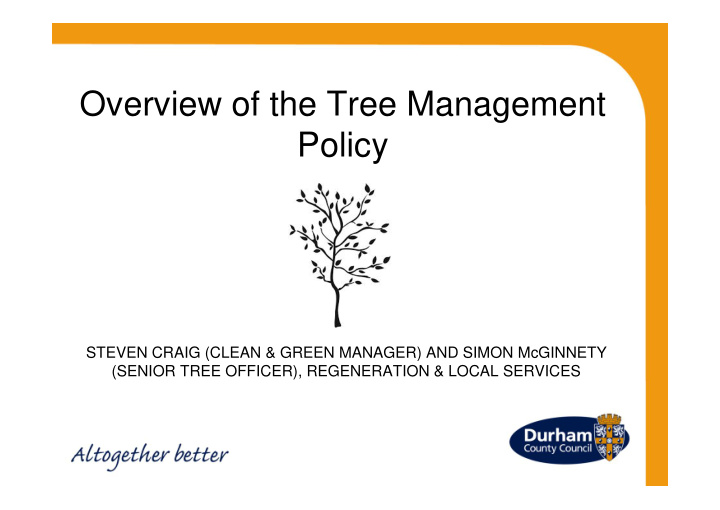



Overview of the Tree Management Policy STEVEN CRAIG (CLEAN & GREEN MANAGER) AND SIMON McGINNETY (SENIOR TREE OFFICER), REGENERATION & LOCAL SERVICES
Background • Trees are a highly valued feature of County Durham • The species, size and nature of our trees varies considerably • Although trees are a very positive feature they can sometimes cause problems, from being a nuisance or inconvenience to potentially causing serious injury or even death • As a tree owner, Durham County Council have a direct responsibility for ensuring our trees do not pose a danger to the public or property and are maintained appropriately • Durham County Council has a duty under the Highways Act to ensure that those trees in private ownership adjacent to the highway do not pose a danger to its users.
Policy Overview • Policy initially came into effect in July 2014 • It brought together a number of tree management policies and practices inherited from the former Councils and was subject to wide public consultation. • Policy was reviewed in July 2017 to take account of any subsequent changes to legislation / codes of practice. • Ensures Service requests consistently responded to and provides a clear basis for decision making • Outlines ways in which the Council will ensure its own tree stock is in a safe condition
• A number of Town & Parish Council’s and the County Durham Housing group have adopted the policy for use on their own areas. • The policy is governed by arboricultural best practice and guided by recommendations within British Standards for tree works. • The policy is a guide and the circumstances on the ground may involve a combination of factors identified therefore some element of discretion is required
Tree Maintenance • Majority of our tree stock is safe and healthy • Trees are naturally growing / evolving organisms that do not generally need active management / attention. • Lots of regular pruning / maintenance work to trees is neither needed nor desirable. • Policy informs what we will / will not do and helps to prioritise works / resources. • For example severe crown reduction / topping is not normally carried out as it can severely affect tree health or encourage a flush of weak re-growth.
DEALING WITH TREE CARE - GUIDANCE •Obstructing / Overhanging Tree Branches •Shading and Loss of Light •Loss of Views •Trees affecting reception (television / satellite / solar Panels) •Overhead Cables / Telephone Wires •General / Minor Nuisances e.g. falling leaves, sap, blossoms, fruit, nuts, birds and insect droppings •Poisonous fruit / foliage •Trees considered too big / too tall •Causing a detriment to the health of residents
DEALING WITH TREE CARE - GUIDANCE The policy is a guide and the circumstances on the ground may involve a combination of factors identified therefore some element of discretion is sometimes required in the application of the policy.
Any Questions?
Recommend
More recommend